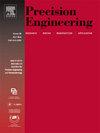Aspheric grinding surface accuracy optimization by integrating sensitive geometric error detection and in-situ compensation processing
IF 3.7
2区 工程技术
Q2 ENGINEERING, MANUFACTURING
Precision Engineering-Journal of the International Societies for Precision Engineering and Nanotechnology
Pub Date : 2025-05-20
DOI:10.1016/j.precisioneng.2025.05.013
引用次数: 0
Abstract
In-situ compensation processing represents an efficacious strategy for enhancing the surface accuracy of aspheric grinding operations. However, during the compensation grinding process, geometric errors can induce deviations in the grinding trajectory, thereby adversely affecting the corrective outcomes for surface accuracy. Consequently, this study introduces an optimization method for aspheric grinding surface accuracy that integrates sensitive geometric error identification with in-situ compensation processing techniques, aiming to mitigate the impacts of geometric errors on compensation processing performance. Initially, a volumetric error model of the grinding machine was established based on multibody system theory, and the evolution pattern of the peak-to-valley (PV) values under the influence of geometric errors for various types of optical components was simulated and analyzed. Subsequently, using actual inverse kinematics, analytical expressions for the computer numerical control (CNC) code for compensating geometric errors across various motion axes of the grinder were derived. Thereafter, a geometric error-surface accuracy model (GE-SAM) was constructed to elucidate the interrelationship between geometric errors and surface accuracy. Based on this model, a global sensitivity analysis was employed to identify critical geometric error terms affecting the surface accuracy of aspheric grinding, which further streamlined the analytical expressions for the compensation CNC code. Finally, the efficacy of the proposed method was substantiated through experimental validation. The experimental results demonstrated that the surface accuracy optimization strategy proposed in this paper is more effective than the traditional in-situ compensation processing method.
基于敏感几何误差检测和原位补偿的非球面磨削精度优化
原位补偿是提高非球面磨削精度的一种有效方法。然而,在补偿磨削过程中,几何误差会引起磨削轨迹的偏差,从而对表面精度的校正结果产生不利影响。因此,本研究提出了一种将敏感几何误差识别与原位补偿加工技术相结合的非球面磨削精度优化方法,旨在减轻几何误差对补偿加工性能的影响。首先,基于多体系统理论建立了磨床的体积误差模型,仿真分析了不同类型光学元件在几何误差影响下的峰谷值演化规律。随后,利用实际的运动学逆解,导出了补偿磨床各运动轴几何误差的计算机数控(CNC)代码解析表达式。在此基础上,建立了几何误差-曲面精度模型(GE-SAM),阐明了几何误差与曲面精度之间的相互关系。基于该模型,采用全局灵敏度分析方法识别影响非球面磨削表面精度的关键几何误差项,进一步简化了补偿数控代码的解析表达式。最后,通过实验验证了所提方法的有效性。实验结果表明,本文提出的表面精度优化策略比传统的原位补偿加工方法更有效。
本文章由计算机程序翻译,如有差异,请以英文原文为准。
求助全文
约1分钟内获得全文
求助全文
来源期刊
CiteScore
7.40
自引率
5.60%
发文量
177
审稿时长
46 days
期刊介绍:
Precision Engineering - Journal of the International Societies for Precision Engineering and Nanotechnology is devoted to the multidisciplinary study and practice of high accuracy engineering, metrology, and manufacturing. The journal takes an integrated approach to all subjects related to research, design, manufacture, performance validation, and application of high precision machines, instruments, and components, including fundamental and applied research and development in manufacturing processes, fabrication technology, and advanced measurement science. The scope includes precision-engineered systems and supporting metrology over the full range of length scales, from atom-based nanotechnology and advanced lithographic technology to large-scale systems, including optical and radio telescopes and macrometrology.

 求助内容:
求助内容: 应助结果提醒方式:
应助结果提醒方式:


